WASAKA III
This page is under construction. Last updated 20041205
|
|
|
|
A Short History of the Classic Antique Power Yacht
WASAKA III
by David L. Higgs
The WASAKA III is a fifty-three foot wooden power yacht designed by Ralph E. Winslow (of Quincy, Massachusetts) and constructed at the Britt Brothers Yard (Lynn, Massachusetts). The WASAKA III, then named the OCTALEE VI, was launched in the spring of 1912. The OCTALEE VI was designed and constructed for Mr. Edmund H. Tarbell of Boston, Massachusetts. His last in a series of seven similar power yachts build for him based on his own personal experience owning and handling power craft along the New England coast.
Photograph 1 show the OCTALEE VI moored at the Boston Yacht Club, South Boston Station, July 2, 1912, Mr. Tarbell sold the OCTALEE VI to Mr. Ingersell Amory, also of Boston, during the winter of 1912--1913 (a Broker advertisement was placed in YACHTING, October 1912, page 210, offering the OCTALEE VI for sale). Photograph 2 show the OCTALEE VI, now renamed CHEECHAKO as she appeared on September 1, 1913, during the Labor Day Boston Yacht Club cruise (Both photographs 1 and 2 were taken by Nathaniel Stubbiness, a noted marine photographer. These two photographs were located in the Stubbiness Collection at The Society for the Preservation of New England Antiquities, Boston, Massachusetts).
About 1917, Mr. John J. Martin, of Boston and Marblehead,
Massachusetts,
purchased the CHEECHAKO and renamed her the WASAKA III. In 1917/1918,
the
U.S. Navy chartered the WASAKA III (for a dollar a year) from Mr.
Martin
for use in defending Boston Harbor during World War I. The Naval
renamed the WASAKA III, naming her the SP 342. The SP 342 was assigned
to the Boston Section of Coast Patrol, First Naval District.
|
(MB: l.
53'0"; b. 10'0"; s. 9.0 k.; cpl. 6; a. 1 1-pdr., 1 Colt mg.) Wasaka
III—a
wooden-hulled motorboat—was built at Lynn, Mass., by
Britt Brothers, boat builders. Acquired
by the Navy in the spring of 1917 from Mr. John J. Martin of Boston under a
free-lease
agreement, Wasaka III was apparently manned on 22 April 1917,
as her deck log
indicates that the first men—the
most senior rating being a Machinist's Mate 2d Class A.
Rowbottom,
USNRF—reported on board on that day. There is
no record of a commissioning, and the deck log does not start until 1 June 1917.
Initially, Wasaka III—classified SP-342—operated from the Commonwealth Pier, Boston, Mass. On 26 September 1917, she shifted to the Bumkin Island section base, whence she operated for the duration of the war and into 1919. Her log ends on 31 March 1919, and she was returned to her owner on 18 April of the same year. |
While in naval service, SP 342 carried a crew of 6. One
officer
and 5 enlisted men. A one pound gun was mounted on stern and a machine
gun was mounted on the forward deck for defense. SP 342s naval log
book(s)
are located in the National Archives, Washington, D.C.
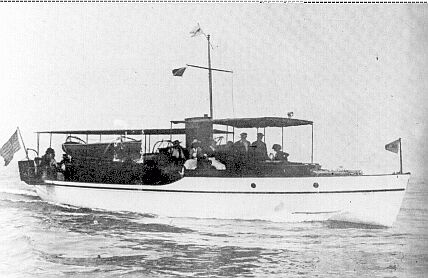 |
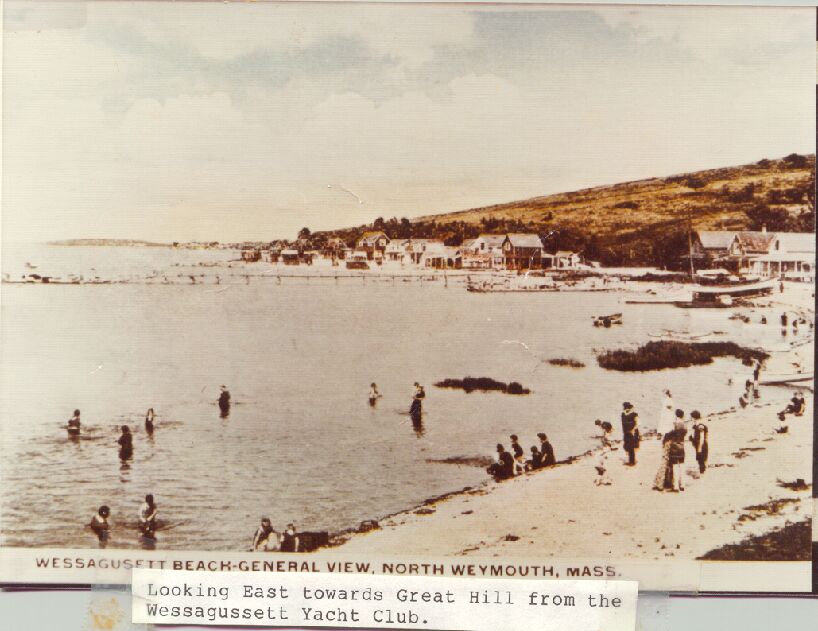 |
|
Photograph 3 |
Old Post Card (1930?) Showing the Wasaka III hauled out on Wessagusset Beach (Weymouth, Mass) [at the Far right] |
At the end of World War I, SP 342 was return to Mr. Martin
ownership.
Mr. Martin owned and continue to use the WASAKA III until 1930. During
Mr. Martin ownership (Phonograph 3), the WASAKA III cruised the Maine
coast
many times. One such cruised is documented in the 1927 Boston Yacht
Club
Year Book. During Mr. Martin ownership, he added a Commendation Ladder
on the starboard side, installed a canvas cover aft of the control
station
to the stern and relocated the ship’s tender and added a second
tenders.
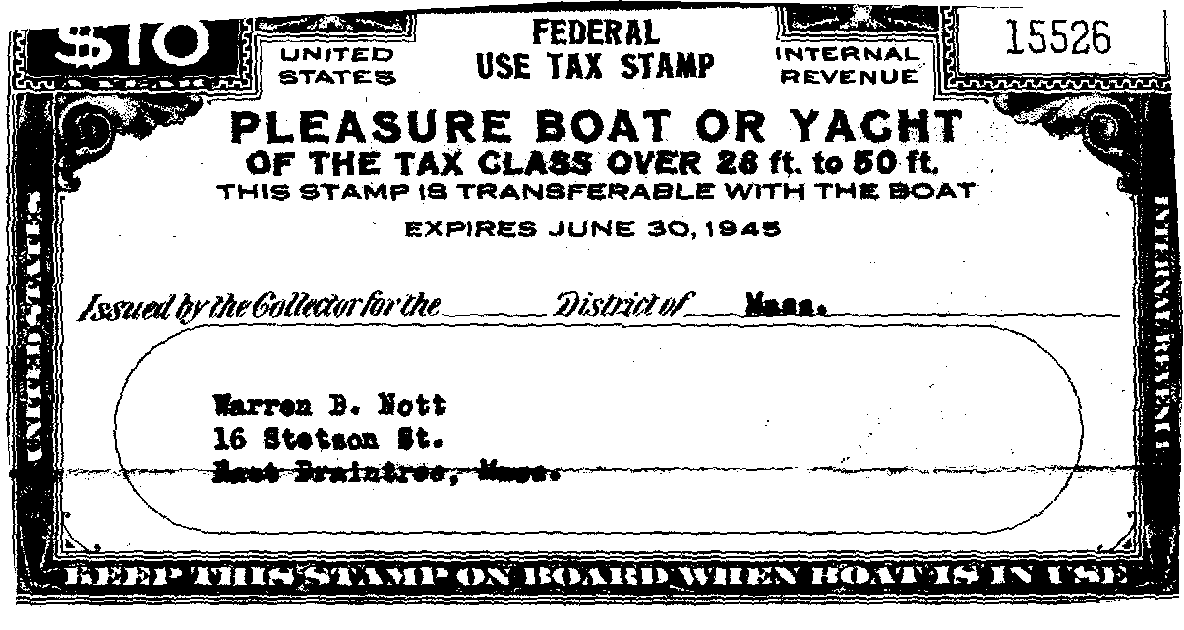
In 1930, the WASAKA III was purchase by Augusts M. Summers, of
Weymouth,
Massachusetts. In 1935, Mr. Summers sold the WASAKA III to Mr. Elmer R.
Blenis, also of Weymouth, Massachusetts. While, Mr. Blenis owned the
WASAKA
III he installed the forward Wheel House, enclosing the open control
station.
He also removed the Muray & Tregurtha motor and installed a 1935
Lycoming
cylinder engine. Mr. Blenis saved the WASAKA III from destruction
during
the 1938 Hurricane by running her, at her mooring in Weymouth, under
full
power during the peak of the hurricane. Mr. Blenis sold the WASAKA III
to Mr. Warren B. Nott, of Braintree, Massachusetts, in 1939.
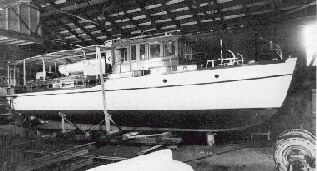 |
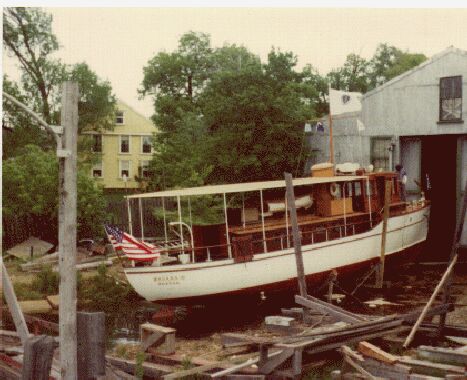 |
|
Photograph 4 |
Photograph 5 |
Photograph 4 was taken around 1945 and shows the WASAKA III hauled out in her specially constructed Boat Shed at a small boat yard Mr. Nott
constructed in the 40’s. This photograph also shows how the WASAKA
III
looks today.
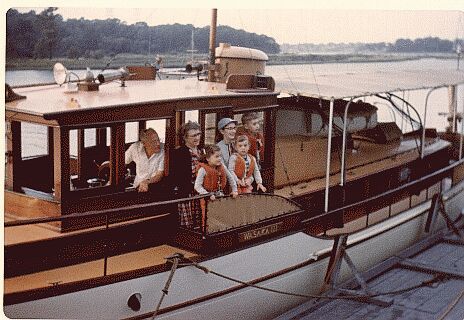 |
| David Higgs (age 7, on the right) on the WASAKA III with his two sisters, mother, grandmother, and grandfather, Warren B. Nott. Summer, 1955 |
Mr. David L. Higgs is the current owner- of the WASAKA III. He
acquired the WASAKA III in 1974. Photograph 5 was taken, launching day,
May, 1974. Photograph E shows the WASAKA III at Weymouth Back River and
photograph F show the WASAKA III returning from a trip in Upper Boston
Harbor in 1975. The last year that the WASAKA III was in full
commission,
in the water, was in 1976. The WASAKA III has been maintained in
storage
since 1976.
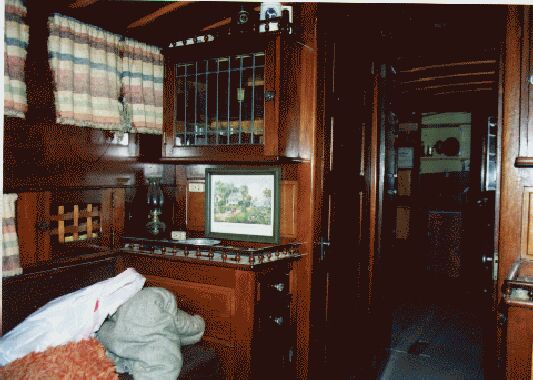 |
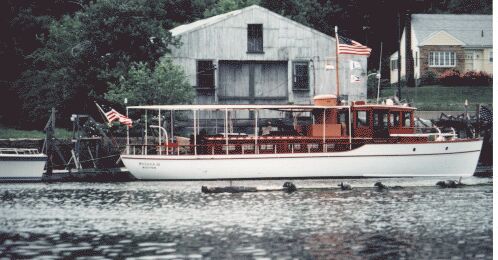 |
| Looking forward into the aft cabin on the WASAKA III. | WASAKA III, Summer 1977 |
The WASAKA III is a 53 foot wooded, double ended, canoe stern, gas screw power vessel documented since 1913 (#218704). She has a Extreme Breath of 11 and a Draft of 5-0. The hull is Carvel, constructed of white oak frames with Long Leaf Yellow Pine planking. The hull is finish white above the water line. The Wheel House, the aft trunk cabin and forward trunk cabin and Deck Rails are all constructed of Honduras Mahogany, Finish Bright. The stern, port and starboard Decks are all Yellow Pine, also finish bright. Main access to the Engine Room is through a companionway in the Wheel House, secondary access is through the Galley from the forward main cabin. A 10’, 1920s Old Town Tender is stored on deck, aft of the Wheel House. A Mahogany Commendation Ladder, Finish Bright, is located aft on the starboard side of the stern cockpit for the use of the owner and his guests when boarding.
The Smoke Stack is mainly decorative. It contains a 32v air
compressor
and air tank for the air horn. The Stack also supplies added
ventilation
to the Galley located below. On each side of the Stack, on deck, there
are two large water tight storage lockers. One locker is used to store
the L.P. gas tank and ships lines, the other is used to hold the ships
lifesaving equipment. A large canvas canopy, supported by a pipe frame
work, covers the WASAKA III from just aft of the Wheel House to the
stern,
proving protection for the crew and guests from sun and inclement
weather.
The WASAKA III engine and lighting generator equipment are all located
in a full height Engine Room located under and forward of the Wheel
House.
Main access to the Engine Room is from the Wheel House. The Engine Room contains the ship engine, lighting generator, batteries, a small work bench and storage lockers for engine room supplies. Forward of the Engine Room is the Crew Quarters. The Crew Quarters contains two pipe berths, storage lockers and a Water Closet for’ the crew. Forward of the Crew Quarters is a large Rope Locker. Forward of the Wheel House on the Bow deck, above the Rope Locker’, are located one manual winch and one power winch (32v). The WASAKA III two ships Anchors are mounted on the Bow deck, for easy access and use.
The WASAKA is now powered by a 4 cycle, 8 cylinder’ gas 1934 Lycoming engine (110 hp) installed in 1935/36. The reduction gear is 2.05 to 1, turning a 24 x 18, three blade propeller. ]’he WASAKA III cruising speed is 10 knots at 1500 rpm, without any wake. Ship lighting is supplied by a 32v, d.c., 2.5 Kw gas generator that charges a 32v bank of Edison Nickel-Iron-Alkaline storage batteries. The gasoline capacity is 300 gallons, stored in two heavy copper tanks located aft under the stern cockpit. Cruising range is in excess of 300 miles.
Located under and aft of the Wheel House is the Galley. The Galley is equipped with a two level ice box, sink, (L.P.) gas stove and storage lockers. The two fresh water tanks (150 gallons total) are located under the two berths in the forward main cabin. Access to the galley is either through the Engine Room or from the forward main cabin.
The stern contains a self bailing cockpit with Yellow Pine planking with a built-in Mahogany Stern Seat. The cockpit area is trimmed in Mahogany. Planking, seat and trim all are Finish Bright. Access to the rudder post is through a hatch in the stern cockpit floor”. An emergency Tiller is stowed next to the rudder post and can be attached to the rudder post in the un-likely event that the steerage cables should break. Just aft of the rudder post, under the stern deck, is a small rope locker.
The companionway at the stern cockpit leads forward (and down)
into the first of the two main cabins for the owner and his guests.
Both
cabins are finish in Honduras Mahogany with a Butternut 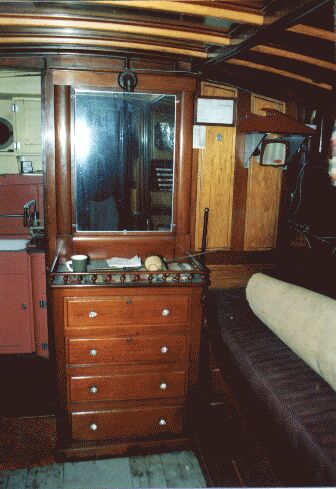 trim,
deck house beams are oak, the ceiling is also Mahogany, all are Finish
Bright. The first cabin contain two day couches that each convert to a
berth. Between the first cabin and the second cabin, on the starboard
side,
is located a Toilet Room with a Water Closet and Sink. On the port side
is located a large walk-in Locker. Forward of this Locker and the
Toilet
Room is the second main cabin. It contains a fixed ship double berth on
the starboard side and a day couch that converts to a double berth on
the
port side. A feature of this cabin is the large Mahogany Bureau with
mirror.
trim,
deck house beams are oak, the ceiling is also Mahogany, all are Finish
Bright. The first cabin contain two day couches that each convert to a
berth. Between the first cabin and the second cabin, on the starboard
side,
is located a Toilet Room with a Water Closet and Sink. On the port side
is located a large walk-in Locker. Forward of this Locker and the
Toilet
Room is the second main cabin. It contains a fixed ship double berth on
the starboard side and a day couch that converts to a double berth on
the
port side. A feature of this cabin is the large Mahogany Bureau with
mirror.
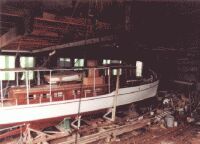 |
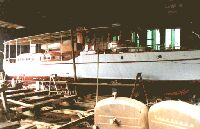 |
| WASAKA III, 1997 |